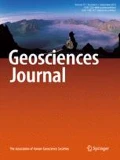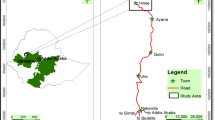Abstract
Techniques for geological hazard management, assessment and prediction must be developed for the prevention and mitigation of geological hazards. To enable this, data sets related to geological hazard prevention related must be constructed, analyzed and distributed to customers. For this, a spatial database (SDB) including geological hazards, basic maps, damageable objects, satellite imagery, meteorological data and terrain analysis data was constructed using GIS, and to manage the SDB, a geological hazard information system (GHIS) was developed. The SDB is covering most area of South Korea and was formed at national, regional and medium scales separately in the form of index and administrative district unit. Using the GHIS, the SDB can be selected according to scale, locality and different types of data, and can be edited and manipulated. For the application of the constructed SDB, landslide hazard was analyzed for the Janghung area, Korea. Landslide susceptibility was analyzed using the landslide-occurrence factors by frequency ratio model. For the verification, the result of the analysis was applied to study areas. The verification results showed satisfactory agreement between the susceptibility map and the existing data on landslide locations.
Similar content being viewed by others
References
Baeza, C. and Corominas J., 2001, Assessment of shallow landslide susceptibility by means of multivariate statistical techniques. Earth Surface Processes and Landforms, 26, 1251–1263.
Chung, C.F. and Fabbri, A.G., 1999, Probabilistic prediction models for landslide hazard mapping. Photogrammetric Engineering & Remote Sensing, 65, 1389–1399.
Donati, L. and Turrini, M.C., 2002, An objective method to rank the importance of the factors predisposing to landslides with the GIS methodology: application to an area of the Apennines (Valnerina; Perugia, Italy). Engineering Geology, 63, 277–289.
Donoghue, D. and Mironnet, N., 2002, Development of an integrated geographical information system prototype for coastal habitat monitoring. Computers & Geosciences, 28, 129–141.
Gauna, I. and Sozza, A., 1999, The geographic information system of the Turin City Council on the Internet. Computers, Environment and Urban Systems, 23, 485–494.
Gokceoglu, C., Sonmez, H. and Ercanoglu, M., 2000, Discontinuity controlled probabilistic slope failure risk maps of the Altindag (settlement) region in Turkey. Engineering Geology, 55, 277–296.
Guzzetti, F., Carrarra, A., Cardinali, M. and Reichenbach, P., 1999, Landslide hazard evaluation: a review of current techniques and their application in a multi-scale study, Central Italy. Geomorphology, 31, 181–216.
Laitinen, S. and Neuvonen, A., 2001, BALTICSEAWEB: an information system about the Baltic Sea environment Advances in Environmental Research, 5, 377–383.
Lee, S., Choi, J. and Min, K., 2002a, Landslide susceptibility analysis and verification using the Bayesian probability model. Environmental Geology, 43, 121–130.
Lee, S., Chwae, U. and Min, K., 2002b, Landslide susceptibility mapping by correlation between topography and geological structure: the Janghung area, Korea. Geomorphology, 46, 149–162.
Lee, S. and Min, K., 2001, Statistical analysis of landslide susceptibility at Yongin, Korea. Environmental Geology, 40, 1095–1113.
Luzi, L., Pergalani, F. and Terlien, M.T.J., 2000, Slope vulnerability to earthquakes at subregional scale, using probabilistic techniques and geographic information systems. Engineering Geology, 58, 313–336.
Ministry of Construction and Transportation, 1988, Korean rainfall frequency map and probable maximum precipitation map. Gwacheon, 71 p.
Oh, K., 2001, Landscape information system: A GIS approach to managing urban development. Landscape and Urban Planning, 54, 79–89.
Parise, M. and Randall, W.J., 2000, A seismic landslide susceptibility rating of geologic units based on analysis of characteristics of landslides triggered by the 17 January, 1994 Northridge, California earthquake. Engineering Geology, 58, 251–270.
Randall, W.J., Edwin, L.H. and John, A.M., 2000, A method for producing digital probabilistic seismic landslide hazard maps. Engineering Geology, 58, 271–289.
Rautelal, P. and Lakheraza, R.C., 2000, Landslide risk analysis between Giri and Tons Rivers in Himachal Himalaya (India) International Journal of Applied Earth Observation and Geoinformation, 2, 153–160.
Rece, A. and Capolongo, D., 2002, Probabilistic modeling of uncertainties in earthquake-induced landslide hazard assessment. Computers & Geosciences, 28, 735–749.
Temesgen, B., Mohammed, M.U. and Korme, T., 2001, Natural Hazard Assessment Using GIS and Remote Sensing Methods, with Particular Reference to the Landslides in the Wondogenet Area. Ethiopia, Physics and Chemistry of Earth (C), 26, 665–615.
Author information
Authors and Affiliations
Corresponding author
Rights and permissions
About this article
Cite this article
Lee, S., Choi, U. Development of GIS-based geological hazard information system and its application for landslide analysis in Korea. Geosci J 7, 243–252 (2003). https://doi.org/10.1007/BF02910291
Received:
Accepted:
Issue Date:
DOI: https://doi.org/10.1007/BF02910291




